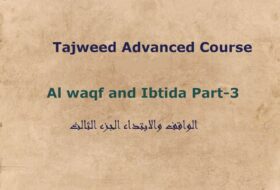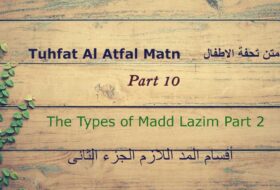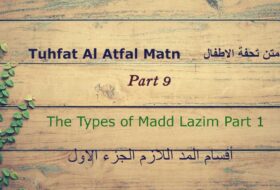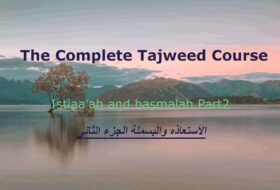Tajweed Course for beginner Part-22
Makharij al Huruf Or Articulation Points part 3 مخــارج الحـروف الجزء الثالث
There are Five major five Makhaarj :
- Al Jawf ( The oral cavity ) الجوف
- Al Halq ( The throat ) الحلق
- Al Lissaan ( The tongue ) اللسان
- Ash-shafatain ( The lips ) الشفتان
- Al Khayshoom ( The nasal cavity ) الخيشوم
3- THE TONGUE ( AL-LISAAN ) الـلســان
Many letters come from the mouth: that is the tongue and its connection with the different areas of the teeth and mouth
There are 4 main makhaarij that can be divided into 10 sub-categories
- The furthest back part of the tongue – this has 2 sub categories
- The middle of the tongue – this single makhraj covers 3 letters
- The side of the tongue – this has 2 specific points of articulation
- The tip of the tongue

1-The furthest back part of the tongue – this has 2 sub categories
ق is pronounced by the extreme back of the tongue touching the upper palate to create a thick sound in the tonsils vicinity, with a round sound (اقْ)
ك The makhraj is slightly in front of the ق This time the tongue should not meet the upper palate other than what is necessary to pronounce the letter. So the sound still comes from the back of the tongue, except this time the tongue is not elevated ( اكْ )
2-The middle of the tongue – this single makhraj covers 3 letters
( ج ش and ى ) These are all pronounced when the middle part of the tongue comes in contact with what lies opposite to it from the roof of the mouth

3-The side of the tongue – this has 2 specific points of articulation
ض The rear side of the tongue touches the upper back teeth (upper molars) in either one of 3 ways : from the right side, from the left side OR from both sides. The left side of the tongue is most commonly used as it is easier than the right, (اضْ)
ل It’s articulation point is the side of the tongue nearest the front of the mouth and the tip of the tongue, and what lies opposite to it of the gums of the first two upper premolars, the two upper canines, the two upper lateral incisors, and the two upper front incisors. ( الْ )
ر Located behind the makhraj of the ن – ارْ

4-The tip of the tongue
It has 5 articulation points with 11 Letters.
1 – (ن).
2- (ر).
3- ( د ط ت ).
4- ( ص س ز ).
5- ( ظ ذ ث ).
ن From the tip of the tongue and what is parallel to it of the gums. It is slightly below the makhraj of laam It’s nasal sound originates from the Nasal Cavity ( ان )
ر From the tip of the tongue and a little from the edge of the tip And what is parallel to it of the gums of the upper front teeth. The tongue is raised from the back for a heavy ر
( ط د ت )
These letters pretty much come from the same place – the difference between them is slight but important. The tip of the tongue meets the base of the top front teeth (place where the gums and teeth meet):
ت Is most forward and exact at the poin t where the gums and teeth meet ( اتْ )
د Is a little further back ( ادْ )
ط Is behind the د a little. The back of the tongu e should also meet the upper palate as it is a thick letter ( ادْ )
( ز ص س )
س The tip the tongue should meet the place where the gums and lower teeth meet. You should allowthe flow of air in the mouth to pass from the back to the front and exit from between the teeth ( اسْ )
ص The back of the tongue elevates to meet the the upper palate as it is a thick letter ( اصْ )
ز For this letter, the teeth should be pressed together that the air passage sounds like a buzzing sound ( ازْ )
( ظ ذ ث ) the tip of the tongue meets the edge of the front upper teeth:
ظ is articulated by putting pressure on the edge of the roots of the upper incisor teeth. The back of the tongue elevates to meet the upper palate as it is a thick letter ( اظْ )
ذ is articulated by putting pressure o n the mid-section of the 2 upper incisor teeth ( ا ذْ )
ث is articulated by putting pressure o n the edge of the 2 upper incisor teeth ( ْاث )

Put any question in comment
READ MORE POSTS:
learn-quran-with-tajweed
surah-nas-translation-tafseer
lam-sakinah-rules













